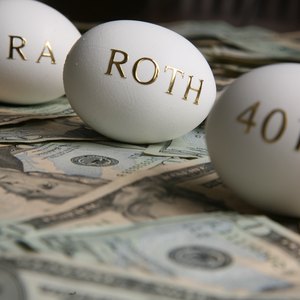
Cashing out a 401k from a former employer is not a difficult task. In most cases, you contact the plan administrator for the appropriate paper work, fill it out, send it to the financial institution that manages the 401k, and wait for the check to come in the mail or for the electronic transfer.
Tips
In order to cash out a 401(k) from a former employer, you will likely have to contact the plan administrator at your former place of employment and request access to the paperwork needed to withdraw your funds.
Handling a Previous 401k
You usually have a few options when it comes to handling a 401k from a former employer. These include leaving the 401k where it is, rolling it into a taxable or nontaxable Individual Retirement Account or transferring it to a 401k with your current employer and cashing it out. Of all your options, cashing out will cost you the most now and in the future. You will have to pay income taxes on the withdrawal along with a 10 percent early withdrawal penalty. You'll also lose the tax benefits offered by the 401k as a qualified retirement plan.
Lump-Sum Distribution
If you decide to do a lump-sum payout of your entire 401k balance, contact your plan administrator for the distribution procedures and paperwork. Most provide a toll-free number to contact a distribution specialist to help you with the process. Keep in mind that the plan is required to withhold 20 percent of the distribution for taxes, and you'll pay a 10 percent early withdrawal penalty when you file your taxes for the year. In other words, for every $1,000 you distribute, $200 is withheld for taxes and another $100 penalty is due when you file taxes.
Partial Cash Out
If you only need some of the cash in the account, you can withdraw that amount and leave the rest in the 401k or do a direct rollover to an IRA with the remaining funds. This allows you to avoid the tax withholding and early withdrawal penalty on the money you leave in the 401k or roll to an IRA. It also keeps that part of your savings growing tax-deferred, meaning you pay no taxes until distributing the money during retirement.
Rolling Over Your 401k
If you roll over your 401k, you can do it directly from your 401k plan to your new IRA account. This way no taxes are withheld. Set up an IRA with the financial institution of your choice, and its representative will help you contact the institution that manages your 401k plan to request a direct rollover. When you do the rollover, you can choose to have a percentage of the account distributed to you in the form of a check, but this part is subject to tax and penalties. You can also withdraw cash from your IRA after you roll over funds, but you'll pay taxes and the 10 percent penalty until you reach the age of 59 and six months.
Short-Term Cash
You can use the 60-day rule to access short-term cash, but you'll have to get the cash back into your new IRA within 60 days of the withdrawal to avoid penalties and taxes. Instead of having the 401k plan send the funds directly to your new account, you can request a check and deposit the funds to the new IRA within the 60-day period. It is still considered a nontaxable rollover if the same amount you withdraw is deposited within the 60-day time frame. Otherwise, you pay ordinary income tax and the early withdrawal penalty on any cash not put in the IRA. You can only use the 60-day rule one time per year.
References
- Fidelity: What to Do With an Old 401(k)
- Fidelity: Rollover Checklist: Three Steps to Roll Over Your 401(k)
- MarketWatch: How to Beat New IRA Rollover Rules
- U.S. Department of Labor. "FAQs About Retirement Plans and ERISA," Page 8-9. Accessed June 22, 2020.
- IRS. "Retirement Topics - Termination of Employment." Accessed August 4, 2020.
- IRS. "Retirement Topics - Exceptions to Tax on Early Distributions." Accessed June 22, 2020.
- Investor.gov. "Mutual Fund Classes." Accessed August 4, 2020.
- U.S. Department of Labor. "FAQs About Retirement Plans and ERISA," Page 13. Accessed June 22, 2020.
- IRS. "Rollovers of Retirement Plan and IRA Distributions." Accessed June 22, 2020.
- FINRA. "401(k) Loans, Hardship Withdrawals and Other Important Considerations." Accessed August 4, 2020.
- IRS. "Retirement Topics - Plan Loans." Accessed August 4, 2020.
- Vanguard. "Commonly asked questions about 401(k) rollovers." Accessed August 4, 2020.
- Carnegie Mellon University. "Moving Funds to TIAA." Page 1. Accessed August 4, 2020.
- IRS. "Rollovers of Retirement Plan and IRA Distributions." Accessed August 4, 2020.
- IRS. "Retirement Plans FAQs relating to Waivers of the 60-Day Rollover Requirement." Accessed August 4, 2020.
- IRS. "Rollovers of Retirement Plan and IRA Distributions." Accessed August 4, 2020.
- IRS. "IRA One-Rollover-Per-Year Rule." Accessed June 22, 2020.
- FINRA. "401(k) Rollovers." Accessed June 22, 2020.
- IRS. "Topic No. 413 Rollovers from Retirement Plans." Accessed August 4, 2020.
- IRS. "Topic No. 558 Additional Tax on Early Distributions from Retirement Plans Other than IRAs." Accessed August 4, 2020.
- IRS. "401(k) Resource Guide - Plan Participants - General Distribution Rules." Accessed August 4, 2020.
- IRS. "IRS provides tax inflation adjustments for tax year 2020." Accessed August 4, 2020.
Writer Bio
Chris Brantley began writing professionally for a financial analysis firm in 1997. From 2000 to 2004, he worked as a financial advisor, specializing in retirement planning and earned his Series 7, Series 66 and insurance licenses. Brantley started his full-time writing career in 2012 and has written for a variety of financial websites, including insurance, real estate, loan and investment sites. He holds a Bachelor of Arts in English from the University of Georgia.

